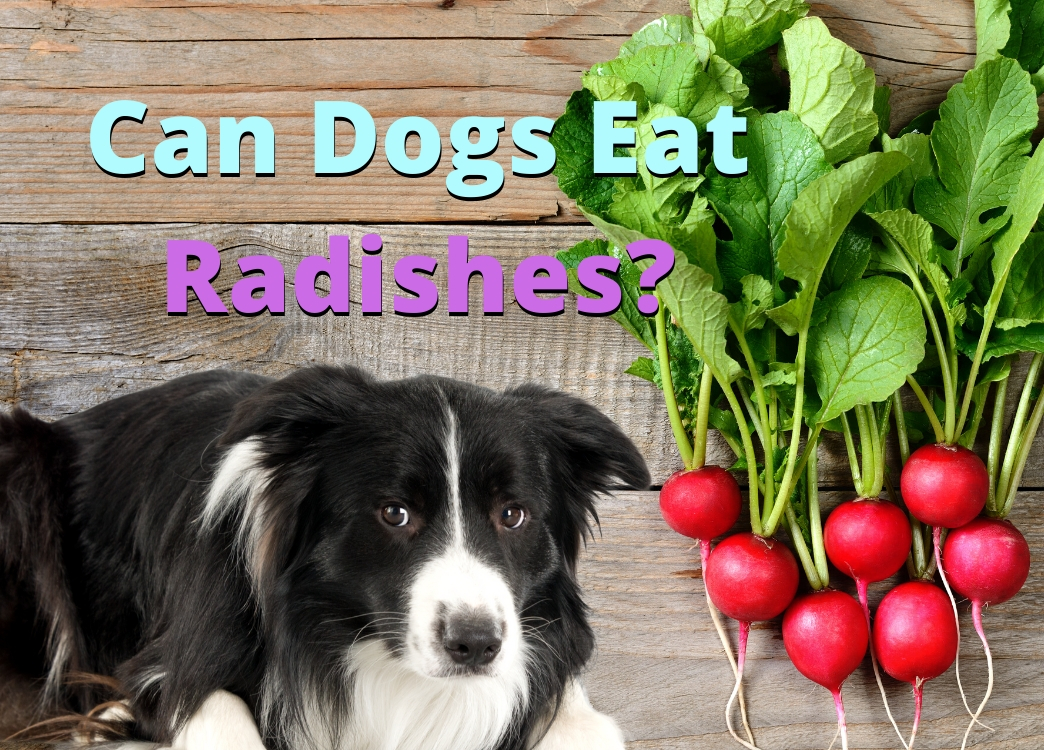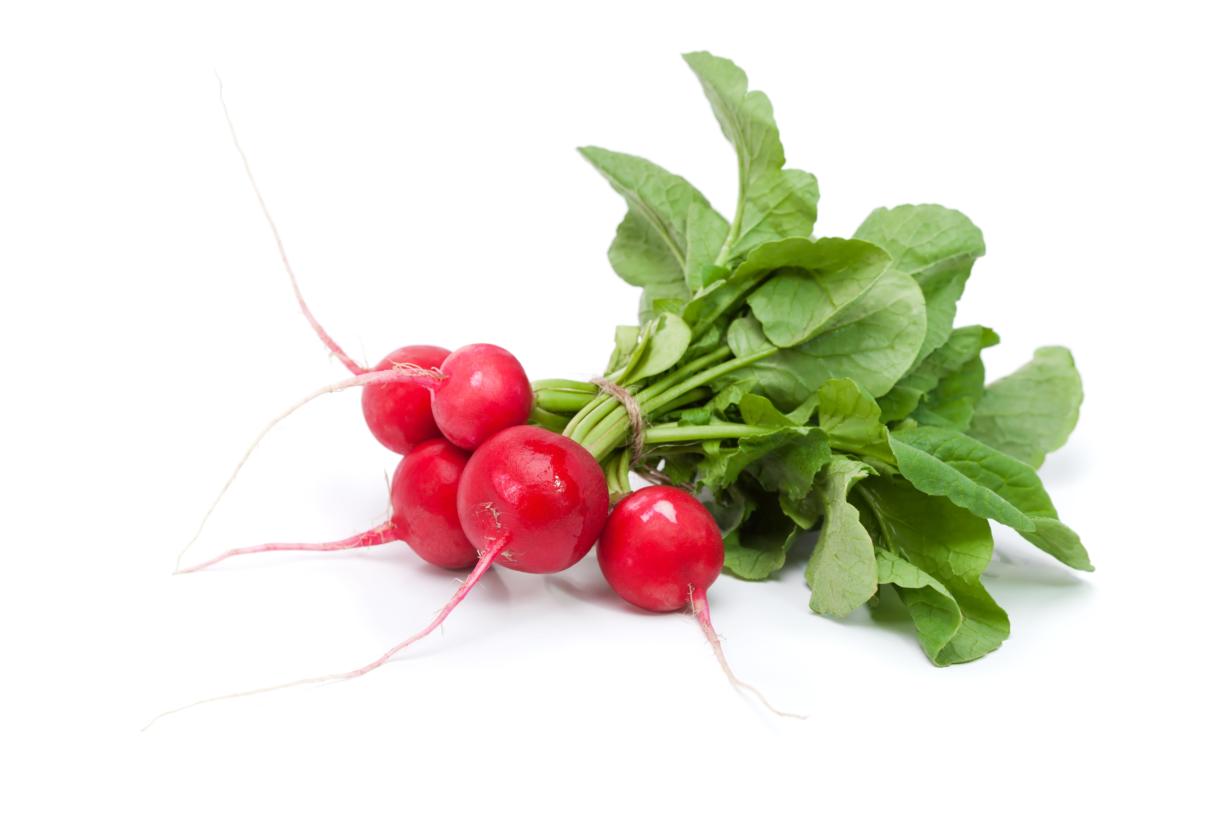
When the weather is warm, the last thing you want to do is to spend your time in the kitchen. You want quick and fresh recipes that fuel your body without increasing the temperature. Bye-bye stews, oven-baked snacks, oozing cheese on top. On a sunny day, you crave the fresh crunch of a delicious salad! We have all grown to appreciate the vitamin boost we get from our spring and summer salads. It’s an explosion of colors and flavors in a bowl! And they can be so cooling at the same time.
As a pet owner, you probably wonder if your dogs could also appreciate the freshness of a homemade salad. As you find yourself tossing lettuce and slicing tomatoes, you can’t help but ask if there’s something small and crunchy you could give your dog. And that’s when you see it, the bunch of fresh radishes lying on the kitchen top, ready to be sliced. You move a hesitating hand towards the peppery pink snack. Rex’s loving eyes following your movements aren’t going to answer the question for you. If anything, Rex is probably going to give it a go if you were to give him a small radish. You’re the master, and he trusts you. And it doesn’t matter how much you rack your brains. Your vet never mentioned anything about radishes.
Are radishes good for dogs anyway?
There’s a good reason why people love radishes. They are a spicy flavor that tickles the taste buds in a pleasant way. When the weather is hot, the burst of peppery taste combined with the freshness of raw radishes is the perfect snack to go! Besides, it’s guaranteed to elevate your salad without needing to rely on additional dressing sauce. As such, we can’t have enough radishes!
Could it be a treat you can share with your dog? The answer is yes, dogs can eat radishes, they are super healthy and are a great alternative to dog food. You don’t need to worry about nutritional value, desperately asking Siri or Alexa “can dogs have radishes?”. Radishes are a yummy vitamin bomb that is beneficial both for humans and dogs. They are high in potassium and vitamin C, which are good for your dogs. Potassium helps control brain and heart function, muscle activity, and nerve impulse, which keeps dangerous conditions such as hypokalemia at bay – it’s a condition in which blood potassium levels are too low. A snack filled with potassium, such as radishes, is a great way to maintain healthy levels for dogs at risk. In addition to this, they also remove plaque, so healthy for teeth too!
Additionally, radishes are high in fiber, making them the perfect go-to treat for dogs with digestive problems. A dog that struggles with constipation could find relief with a few radish snacks to help stool move through the intestines. A word of warning, however: You can’t replace medical treatment for digestive conditions with snacks that are rich in fiber. It’s worth asking your vet for advice if your dog has a fragile digestive tract to make sure you can avoid aggravating an underlying condition. But for dogs that don’t have any identified digestive problems, radishes are a healthy and yummy treat.
Last but not least, the crunchy element and the rough skin of radishes are a great addition to your dog’s mouth hygiene. They help to remove plaque as your dog chews them. If you’re worried about keeping your dog’s teeth as clean as possible, a regular radish-based snack is a quick and easy tip that goes a long way!
A side note on the nutritional value of radishes

There is no denying that radishes are healthy. But it’s essential to consider their nutritional value from a dog’s perspective. While radishes are high in potassium, fiber, and vitamin C, your dog doesn’t need the same intake in minerals as you do. Fiber is good to fight off constipation. Potassium, in small quantities, can boost the body functions. However, be careful not to use high potassium doses as it could backfire on your dog’s health.
Vitamin C is a vitamin that we need for our health. Dogs, however, produce their own vitamin C at the rate of 18 milligrams per pound of body weight per day. In other words, a healthy dog doesn’t need any vitamin C supplement.
Wait, if dogs don’t need the nutritional goodness from a radish: Are radishes bad for dogs? Not really. Radishes are not poisonous in small quantities. The spicy flavor comes from compounds in the radish, including isothiocyanate, which can be toxic to dogs when ingested in large quantities. Some dogs are especially sensitive to the compound and can develop indigestion symptoms even for small quantities. Thankfully, the sharp taste can be unpleasant for dogs in large quantities, which means it almost acts as a safety mechanism! Ideally, if you want to share your salad with your dog, it would be a better choice to use carrot or cucumber, which sits well with your dog’s stomach. Cucumber is an excellent replacement if your dog doesn’t like radishes, as it is equally low in calories and gives your pet a break from dog food. Cucumbers may also remove plaque, which is why we think they are awesome.
Can dogs eat them whole?
Dogs that can stomach the spicy compound in the radishes are safe to consume them as an occasional snack. If you are worried about whether you need to separate the radish from the leaves for your dog, the answer is yes. Dogs can eat radishes whole, including the leaves. Ideally, homegrown radishes are a better choice as you can control what goes on your vegetable bed. For radishes bought in shops or at the local market, you want to make sure to give each plant a good wash before sharing them with your dog.
If you are growing your own vegetables, though, it’s important to keep an eye for wild radishes. Wild radishes can grow freely all across the country, but they tend to be more prominent in residential gardens where people already cultivate radishes. Wild radishes are highly toxic to dogs, so it’s best to identify them swiftly to remove them. You can think of them as poisonous weeds, even though they are safe for human consumption. How do you recognize wild radishes? They are not related to radishes, despite the name. Their flowers tend to be yellow or white, but you can also find lavender-colored flowers. They also have hairy green leaves, which makes them easy to spot compared to cultivated radishes. There is no better way to get rid of them than physical removal. As they self-seed, they are more than likely to come back the following year but, for your dog’s safety, you should make a point of having a wild radish-free garden.
Do dogs like to eat radishes anyway?
We’ve mentioned the tangy peppery taste of radishes. That’s why we love them. And for some dogs, it’s a lovely burst of flavor. For other dogs, the sharp taste is a major turn off. Ultimately, it’s a matter of taste, and there is no right or wrong about it. One important thing to remember, though, is that if Rex doesn’t like radishes, you can use other fresh vegetables as a replacement. As mentioned earlier, you can give your dog a few sticks of cucumber in summer instead of radishes. The mild flavor of cucumber (can dogs eat cucumber?) is easier on dogs who dislike the spiciness of radishes.
The key is to let your dog try and see what works and what doesn’t. You shouldn’t force your dog to eat radishes just because they are a healthy treat high in fiber.
Preparing radish sprout treats for your dog
If your dog enjoys radishes, you’ve got a few ways of preparing their favorite treats. Dogs eat radishes and radish seeds, which gives you plenty of choices. Sprouted radish seeds are a yummy treat but can take some work to prepare. You will need to soak them in water for half a day. Then you can drain them, ensuring each seed is clean, and they need to go in a jar with a sprouting lid. If you don’t have a sprouting top, you can use a thin cheesecloth instead. Do make sure to keep the seed clean to avoid mold growth. You should give them a quick rinse every few days to moisturize them and keep them bacteria-free. It takes approximately 3 to 4 days to grow sprouts.
Feeding tips for radishes
Dog owners need to understand how to measure the right portion size for their dogs. Radishes are a great snack in moderation. Here is how many radishes dogs can eat based on weight:
- Small dogs that are 10 lbs or under: 1-2 teaspoons seeds sprinkled over food, sprouts, green pre-sliced leaves. They should consume no more than half a radish, either whole or sliced.
- 30 lbs dogs: 1-2 tablespoon seeds, sprouts, or greens. No more than 1 radish, while or sliced.
- 70 lbs dogs: You shouldn’t give more than ¼ cup of seeds, sprouts, or greens.
You can also freeze radish treats for a fresh summery snack for your dog to eat later.
Dogs that don’t like to eat raw radishes may prefer to eat cooked radishes, which are milder in flavor. It’s worth trying a few options before deciding that your dog really does like to eat radishes!
In addition, you may be interested to read the following posts:



















